Interested in the 15 BEST Day Trips From Valencia For 2024?
Want to know more about Day Trips from Valencia? Keep reading for my top 15 choices for Day Trips from Valencia in 2024
In this guide, I have provided detailed location information, the distance from Valencia, the best ways to get there, and how long it will take. As an avid and experienced Spain traveler since childhood, I have discovered some of the BEST cities in Spain, especially along the eastern coast, and have done additional research to find some of the best one-day excursions to help plan your Valencia trip!
Valencia’s strategic geographical position makes it an ideal hub for exploring so much of Spain, ideal for easy day trips. Surprisingly, Valencia is often overshadowed by the glitz of Barcelona or the charm of Madrid. Sometimes overlooked, Valencia offers so much, from its beaches to its fabulous Science Center, amazing old town with Roman ruins, and of course cuisine – home to arguably Spain’s best Paella.
Short on Time? Scroll Through the 15 Best Day Trips From Valencia
Most of the Best Day Trips are about an hour or less away so you can spend half a day if you prefer and return to enjoy more of Valencia. There are a couple that are two hours away, so you might consider spending the night or skip it and stick to the short travel day trips instead.
This list is organized from closest to furthest day trips:
You might find that hopping on a guided day tour is the most efficient option, so we’ll provide some suggestions for those too. If you have a car, most of these are easy to explore on your own schedule, even combining two for a full-day-trip from Valencia.
1. El Saler (16 minutes)
El Saler, a tranquil beach near Valencia, is perfect for day trips from Valencia. It’s favored by locals for its unspoiled sands, rolling dunes, and unique flora, leading to a picturesque pine forest. Ideal for nature lovers and a peaceful retreat, El Saler offers scenic paths for walking and biking. Its proximity and easy accessibility make it one of the best day trips for those seeking a serene escape.
Distance from Valencia: Approximately 10 miles (16 kilometers)
Best way to get from Valencia to El Saler:
- By Car: Renting a car provides the most flexibility. Take the CV-500 road south from Valencia, which will lead you directly to El Saler. Having a car allows you to explore the surrounding areas at your own pace.
- By Bus: Bus 25 departs from Valencia city center (Calle Cerdán de Tallada) and travels directly to El Saler. During the summer months, the bus route goes all the way to El Saler Beach. In the off-season, the bus stops at Pinars – El Saler, which is a leisurely 10-minute walk along a picturesque pine tree-lined path to reach the beach.
- By Taxi or Ride-Sharing Services: Taxi and ride-sharing services like Uber or local type companies are available in Valencia. While more expensive than public transportation, they offer a convenient door-to-door service.
- By Bicycle: Valencia is a bike-friendly city, and you can rent a bicycle to reach El Saler. There are dedicated bike paths that lead out of the city, providing a scenic and eco-friendly way to reach your destination.
- Organized Tours: Consider joining an organized tour that includes transportation to El Saler. Tour companies often offer day trips to popular destinations, providing a hassle-free way to explore the area.
2. Port Saplaya and Alboraya: A Charming Duo (20 Minutes)
Port Saplaya and Alboraya are two absolutely lovely towns located just north of Valencia, Spain. Port Saplaya is a coastal town known for its picturesque canals and colorful houses, while Alboraya is a nearby town famous for its horchata, a cold drink made with tiger nuts.
Alboraya is The Home of Horchata
Where I live in San Diego, near the Mexican border, Horchata is made with rice — so this was a refreshing and quite different tasting experience! Alboraya is known for its delicious horchata, a refreshing and nutritious drink made from tiger nuts (actually a tuber not a nut). Horchata is so popular in Valencia that it is consumed just as much as paella.
The cultivation of tiger nuts in Alboraya dates back to the Arab conquest of Spain in the 8th century. At first, tiger nuts were grown for family consumption, but they eventually became a popular commercial crop.
Visitors to Alboraya can visit the Horchata Museum to learn more about the history and production of horchata. They can also sample horchata and other traditional Spanish drinks and snacks at one of the many cafes in town.
Here are some of the other wonderful things you can do in Port Saplaya and Alboraya:
- Visit the canals of Port Saplaya. Rent a boat and explore the canals at your own pace, or you can take a guided tour.
- Visit the Museu de l’Horchata in Alboraya. This museum is dedicated to the history and culture of horchata, a popular drink in Spain and beyond.
- Sample horchata at one of the many cafes in Alboraya. There are a number of cafes in Alboraya where you can sample horchata and other traditional Spanish drinks and snacks.
- Visit the Castillo de Alboraya. This castle is located on a hilltop overlooking Alboraya and offers stunning views of the surrounding countryside.
Distance from Valencia: 12 Miles (19 Kilometers)
Best ways to get from Valencia to Port Saplaya and Alboraya
- By car: The drive from Valencia to Port Saplaya or Alboraya takes about 20 minutes. Take the V-21 motorway north towards Sagunto and exit at junction 4.
- By bus: There is a regular bus service from Valencia to Port Saplaya and Alboraya. The bus ride takes about 30 minutes. The bus stop is located at the corner of Calle Colón and Calle Xàtiva. Bus schedule to Port Saplaya and Bus schedule to Alboraya.
- By taxi: A taxi ride from Valencia to Port Saplaya or Alboraya takes about 20 minutes and costs around €25.
- By bike: You can rent a bike from a number of shops in Valencia and cycle to Port Saplaya or Alboraya. The bike ride takes about 45 minutes

3. Tavernes Blanques (Lladró Factory) – (21 minutes)
Tavernes Blanques, a quaint town on the outskirts of Valencia, is a captivating destination celebrated for its unique blend of history, culture, and artistry. This charming town is home to the renowned Lladró factory, a prestigious Spanish brand renowned worldwide for its exquisite porcelain figurines and sculptures. Visitors to Tavernes Blanques have the rare opportunity to witness the intricate art of porcelain crafting up close, observing skilled artisans at work and gaining insight into the meticulous process behind each delicate piece.
There is a lovely hotel in Valencia where we stayed called Palacio Vallier with incredible Lladro displays and a stunning butterfly chandelier. But you can go and just enjoy an Agua de València and admire the pieces.
Distance from Valencia: Approximately 6.5 miles (10.5 kilometers)
Best ways to get there: (we took a taxi)
- Renting a Car: Renting a car gives you the flexibility to travel at your own pace. Since this is so close, you can combine it with another half-day excursion.
- By Train/Bus: The Spanish national railway service, Renfe offers train services from Valencia to nearby towns. Additionally, regional bus services like ALSA operate routes connecting Valencia to smaller towns in the region.
- Tour: This is by far the easiest and most informative way to enjoy the museum. Best tour of the Lladró factory-museum (from Valencia) with a fabulous Paella lunch!
- By Taxi or Rideshare: Taxis and rideshare services like Uber may provide a more convenient option for traveling directly to Tavernes Blanques from Valencia. Ask your hotel to arrange one.
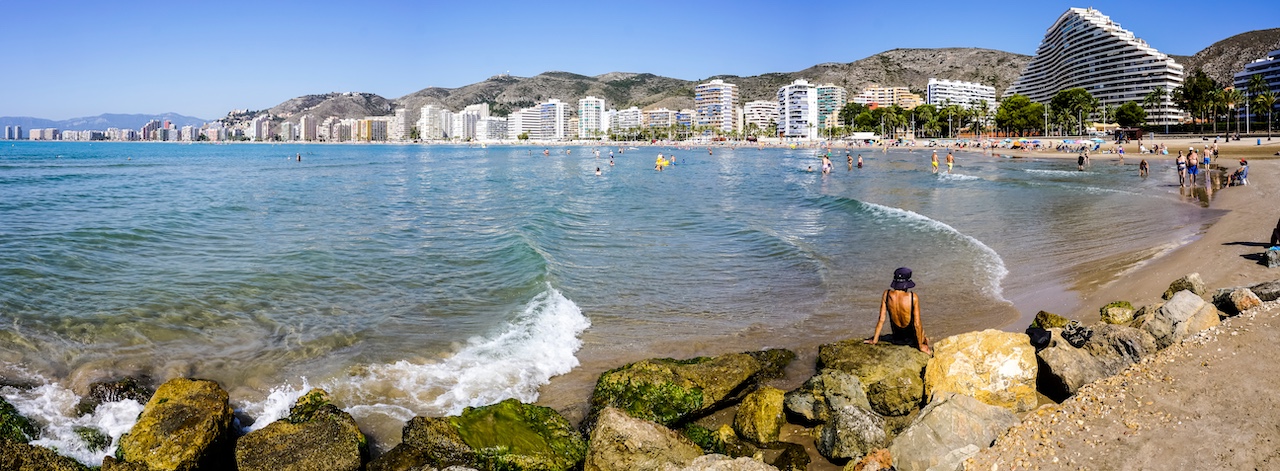
4. Cullera (25 minutes)
The city of Cullera is renowned for its stunning beaches and crystal-clear waters. If beachy day trips are your way to chill, then Cullera should be on the list! With 11 beaches to choose from, there is something for everyone, from families seeking shallow waters and calm seas to adventure seekers craving water sports and diving.
Playa San Antonio, Cullera’s main beach, is a long and sandy stretch of coastline with a wide promenade and ample facilities for all visitors. Its shallow waters and family-friendly atmosphere make it a popular destination for families with young children.
Playa Raco, another popular beach in Cullera, is known for its lively atmosphere and abundance of amenities, including windsurf rentals and beachfront bars and restaurants. Visitors can enjoy a variety of water sports here, such as windsurfing, kitesurfing, and kayaking.
Other popular beaches in Cullera include:
- Playa Marenyet: a secluded beach with soft sand and crystal-clear waters
- Playa El Dosel: a family-friendly beach with a variety of amenities, including a playground and a chiringuito (beach bar)
- Playa Faro: a picturesque beach with stunning views of the Cullera Lighthouse
- Playa Brosquil: a popular beach for windsurfing and kitesurfing
Not interested in Cullera’s beaches?
- Cullera Castle: This imposing 10th-century castle is perched atop a hill overlooking the town and offers stunning views of the Mediterranean Sea. Visitors can explore the castle’s grounds and learn about its fascinating history.
- Old Town: Cullera’s old town is a charming maze of narrow streets and traditional Valencian houses. Visitors can wander around the old town, browse the shops and cafes, and soak up the atmosphere.
- Dragut Cave Museum: This museum is housed in a cave that was once used by the Ottoman pirate and admiral Turgut Reis, also known as Dragut. The museum tells the story of Dragut’s life and his role in the Barbary pirates’ attacks on the Mediterranean coast.
Distance from Valencia to Cullera: 25 miles (40 kilometers)
How to get to Cullera from Valencia:
- By car: Renting a car provides the most flexibility. Drive from Valencia to Cullera via the V-31 motorway south towards Elche, exiting at junction 17. Follow the signs for Cullera. The drive takes about 30 minutes.
- By bus: Take a regular bus service from Valencia to Cullera. The bus ride takes about 45 minutes. The bus stop is located at the corner of Calle Colón and Calle Xàtiva.
- By train: Take a train service from Valencia to Cullera. The train ride takes about 30 minutes. The train station is located at Calle Játiva 29.
- You can buy tickets through Trainline or Omio.

5. Albufera Natural Park (30 minutes) – a MUST do day-trip from Valencia!
Only a short drive south of Valencia lies Albufera Natural Park, a breathtaking oasis that beckons nature lovers and birdwatchers alike. This mesmerizing park encompasses a vast freshwater lagoon surrounded by lush wetlands, teeming with diverse flora and fauna.
Albufera is a paradise for ecotourism, offering visitors the chance to embark on peaceful boat rides across the lagoon, observing native and migratory birds in their natural habitats. From the majestic flamingos to the elusive bitterns, the park is home to over 340 bird species, making it one of the most important birdwatching destinations in Europe.
Beyond its natural allure, Albufera is also a cultural treasure trove, deeply intertwined with Valencia’s history. Nestled amidst scenic rice paddies and charming villages, the park provides a unique blend of natural beauty and rustic charm. Visitors can learn about the region’s rich heritage at the Albufera Museum, while sampling local delicacies at the traditional restaurants lining the picturesque waterfront.
As the sun sets, casting vibrant hues across the water, Albufera Natural Park transforms into a captivating spectacle. Whether you’re seeking a tranquil escape into nature or a culturally enriching experience, Albufera is a must-visit destination for your next trip to Valencia.
Tips for Visitors
- The best time to visit Albufera Natural Park is during the spring and fall when the weather is mild and the birdlife is abundant.
- Be sure to book your boat tour in advance, especially during the summer months.
- Wear comfortable shoes and clothing, as you’ll likely be doing a lot of walking.
- Bring sunscreen, a hat, and water, especially if you’re visiting during the summer.
- Be respectful of the wildlife and avoid littering.
Best ways to get from Valencia to Albufera:
- By car: If you prefer flexibility and want to explore the region at your own pace, renting a car is a great option. The drive from Valencia to Albufera Natural Park takes about 20 minutes. Take the V-31 motorway south towards Elche and exit at junction 14. Follow the signs for Albufera Natural Park.
- By bus: There is a regular bus service from Valencia to Albufera Natural Park. The bus ride takes about 30 minutes. The bus stop is located at the corner of Calle Colón and Calle Xàtiva.
- By taxi: A taxi ride from Valencia to Albufera Natural Park takes about 20 minutes and costs around €25.
- By boat: There is a boat tour that departs from the Marina Real Juan Carlos I in Valencia and takes visitors to Albufera Natural Park. The boat tour takes about 1 hour and 30 minutes.
6. Sagunto: A Historical Town on the Valencian Coast (30 minutes)
The Romans were everywhere and this town is no exception. I always think of them as ROAMans…
Sagunto offers a rich tapestry of history and culture, spanning an awe-inspiring 2,500 years. This coastal town, steeped in heritage, reveals a captivating past through its Roman relics, such as the commanding Sagunto Castle atop a rugged hill and the remarkably preserved Roman theater. But Sagunto isn’t just a living history lesson; it’s a vibrant, modern town where the Mediterranean sun bathes streets lined with lively cafes and enticing tapas bars. With street musicians’ melodies in the air and the savory scent of paella floating around, Sagunto offers an unforgettable sensory experience that stays with you long after you’ve left its enchanting embrace.
There are several tour options from Valencia.
Highlights:
- Sagunto Castle: This impressive castle complex offers stunning views and a glimpse into Sagunto’s military history.
- Roman Theatre: Sagunto’s well-preserved Roman theater, dating back to the 1st century AD, is one of the best in Spain.
- Horno Alto No. 2: This former blast furnace, now a museum, tells the story of Sagunto’s iron and steel industry.
- Archeological Museum of Sagunto: This museum houses a collection of artifacts from Sagunto’s history, including mosaics, pottery, and ceramics.
Distance from Valencia to Sagunto: 30 miles (48 kilometers)
How to get to Sagunto from Valencia:
- By car: If you prefer flexibility and want to explore the region at your own pace, renting a car is a great option. Drive from Valencia to Sagunto via the V-21 motorway north towards Sagunto, exiting at junction 15. Follow the signs for Sagunto. The drive takes about 30 minutes.
- By bus: Take a regular bus service from Valencia to Sagunto. The bus ride takes about 45 minutes. The bus stop is at the corner of Calle Colón and Calle Xàtiva.
- By train: Take a train service from Valencia to Sagunto. The train ride takes about 30 minutes. The train station is located at Calle Játiva 29. You can buy tickets through Trainline or Omio.
7. Carcaixent (42 Minutes)
This enchanting town is located less than an hour away from Valencia. Carcaixent offers a delightful escape in the heart of the Region of Valencia, with a pleasant climate year-round. Situated in the eastern part of Spain, Carcaixent is not just a city; it’s a vibrant municipality known as ‘The heart of the Ribera Alta.’ This town has successfully preserved its cultural heritage for generations.
Carcaixent’s true essence lies in its people – warm, generous, and deeply connected to their farming roots. Carcaixent is a haven for food enthusiasts, offering a delectable array of local cuisines that highlight the flavors of the region.
During your visit, immerse yourself in the town’s history by exploring its well-preserved architecture, and don’t miss the opportunity to indulge in the unique orange-based delicacies, a culinary experience that reflects Carcaixent’s pride as the birthplace of this globally cherished citrus fruit.
Distance from Valencia: Approximately 38 miles (61 kilometers)
Best ways to get to Carcaixent from Valencia:
- By Car: Renting a car provides flexibility and convenience, allowing you to explore the surrounding areas at your own pace.
- By Bus: Several bus services operate between Valencia and Carcaixent, providing a convenient and budget-friendly travel option.
- By Train: Choose a train journey to nearby stations, followed by a short bus or taxi ride. You can buy tickets through Trainline or Omio.
8. Gandia (45 minutes)
Gandia is a beautiful coastal city in the Valencian region of Spain. You could easily do the gateway towns and spend a whole day there exploring the gorgeous beaches. Plus it’s quite close! Enjoys these other towns along the Costa Azahar, such as:
- Peñíscola: A picturesque town with a stunning medieval castle and a lively atmosphere. Visitors can explore the castle’s grounds and learn about its fascinating history, or simply relax on the beach and enjoy the crystal-clear waters.
- Benicàssim: A popular destination for music lovers, Benicàssim is home to the annual FIB festival. Visitors can also enjoy the town’s beautiful beaches, charming old town, and variety of restaurants and bars.
- Castellón de la Plana: The capital of the Castellón province, Castellón de la Plana is known for its modernist architecture and lively cultural scene. Visitors can admire the city’s modernist buildings, visit its museums and galleries, or enjoy a performance at the Teatro Principal.
Gandia’s main beach has a busy beachfront promenade lined with bars, restaurants, and shops. Visitors can enjoy local cuisine, buy souvenirs, or simply relax and take in the views.
Best ways to get to Gandia from Valencia:
-
- By car: Renting a car provides flexibility and convenience, allowing you to explore the surrounding areas at your own pace. Drive from Valencia to Gandia via the V-31 motorway south towards Elche, exiting at junction 20. Follow the signs for Gandia. The drive takes about 45 minutes.
- By bus: Take a regular bus service from Valencia to Gandia. The bus ride takes about 1 hour and 15 minutes. The bus stop is at the corner of Calle Colón and Calle Xàtiva.
- By train: Take a train service from Valencia to Gandia. The train ride takes about 1 hour. The train station is located at Calle Játiva 29.
- You can buy tickets through Trainline or Omio.
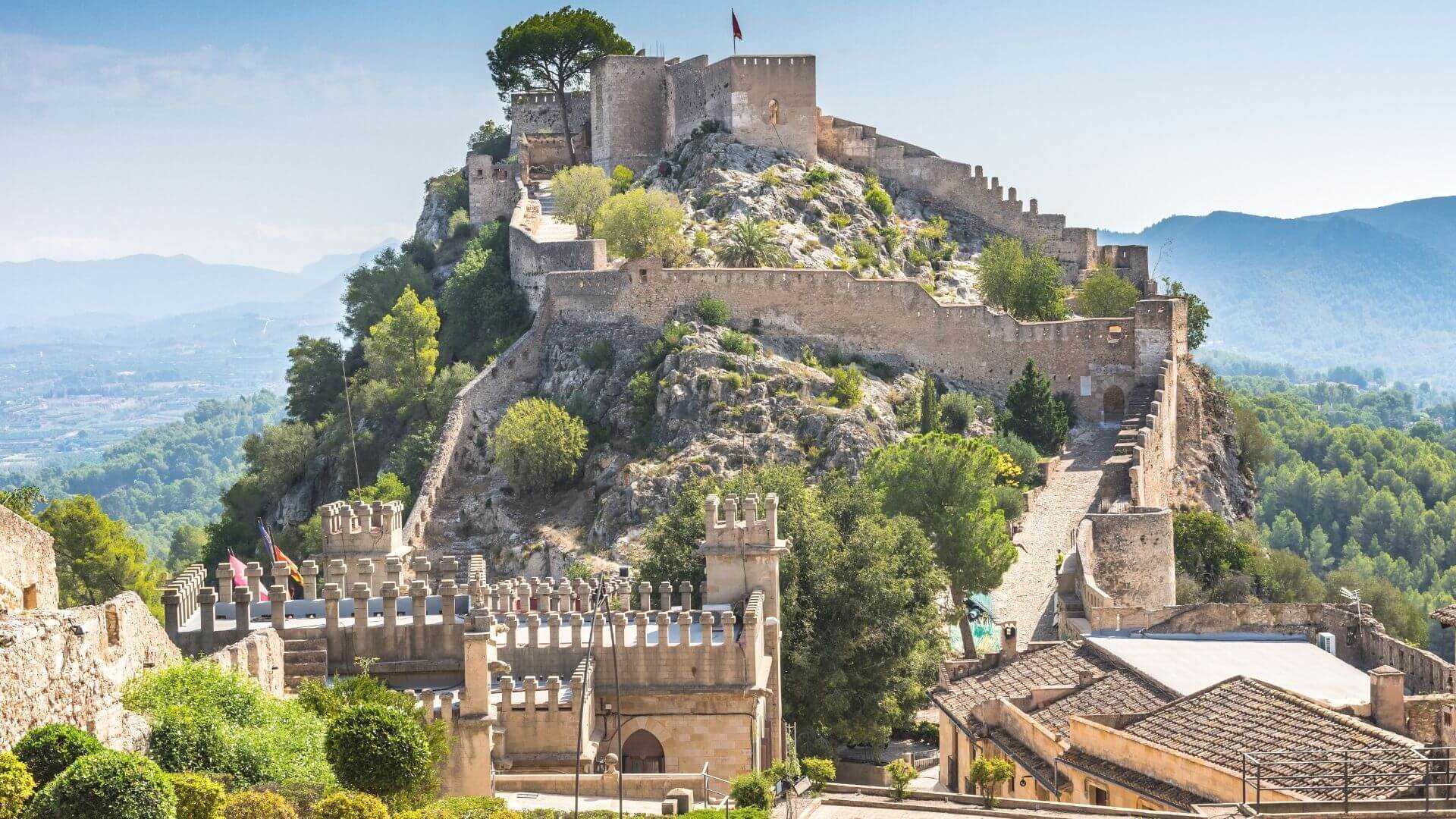
9. Xàtiva (55 minutes)
We really loved our day in Xàtiva! Perched majestically on the mountainside overlooking the scenic city of Xativa, the castle stands as a testament to centuries of history and architectural brilliance. Its unique narrow saddle shape invites visitors to enter at the lowest point, offering a stunning view of the minor castle winding up one side and the major castle sprawling over the other.
This exceptional design gives you a breathtaking 360° view and creates the perfect backdrop for Instagrammable photographs. And, it’s just an hour’s train ride from Valencia Nord station.
The castle’s roots trace back to ancient times, with remnants from the Iberian era and Roman occupation. It witnessed the strategies of Hannibal, the might of the Moorish Almoravid dynasty, and the influence of the powerful Borgia family, known for their colorful escapades.
The castle, once a seat of political intrigue and later a prison, now stands restored to its former glory.
Visitors can explore the castle’s various areas with the aid of free audioguides available on the Xativa Tourism website, enhancing their experience. Alongside the castle, Xàtiva offers more cultural sights, including La Collegiata Cathedral, adorned with statues of the Borgia popes, and Casa de L’Ensenyament, a fine arts museum displaying masterpieces by Ribera and Goya. While exploring, visitors can indulge in traditional Valencian cuisine at La Talaia del Castell, a terrace restaurant within the castle premises, or unwind in Plaça del Mercat, a historic square with charming architecture.
Don’t get caught there during siesta time!!! Few establishments operate during these hours. This is true of most small towns, and even large cities like Barcelona and Madrid!
Distance from Valencia: Approximately 42 miles (68 kilometers)
Best ways to get from Valencia to Xàtiva
- By Train: Renfe, the Spanish national railway company, operates regular train services between Valencia and Alicante. Buy tickets through Trainline or Omio. The central train station in Valencia is known as Estació Nord. You’ll find it at the core of Valencia’s historic district, it serves as the primary gateway for trains traveling to and from the city. There are usually 12 trains per day that run between Valencia and Xátiva, about 47 minutes in all.
- Car: If you prefer flexibility and want to explore the region at your own pace, renting a car is a great option. By car, it takes 45 minutes to 1 hour, depending on traffic conditions.
- Bus: ALSA, the Spanish bus company, also operates bus services between Valencia and Xativa. The journey duration and schedule may vary, so it’s advisable to check the ALSA website or visit the Valencia bus station for the most up-to-date information on bus routes and timings.
- Rideshare (BlaBla Car) or Taxi: Rideshare services like Uber and local taxis are available in Valencia and can offer a convenient door-to-door option for traveling to Xativa. Do negotiate the fare with the taxi driver before the journey. Your hotel can help you out with this.

10. Chulilla Castle and Chulilla Suspension Bridge (1 hour)
Exploring Chulilla is a must, as it stands out as one of the most scenic villages in the Valencia Region. And, I highly recommend this hike, just 45 minutes from Valencia for one of your day trip options. We didn’t expect to be awestruck while traversing the Don Quijote Route and exploring the Lagunas de Ruidera National Park – it seemed almost surreal amidst the surrounding scenery.
Valencia boasts a ton of surprises. Among these treasures is the Chulilla Hanging Bridges Trail, or La ruta de los puentes colgantes de Chulilla in Spanish, which stands out as an enchanting oasis of greenery waiting to be explored in this captivating region. Perched at an altitude of 1,056 feet (322 meters) in the scenic Els Serrans region, this ancient village has witnessed the passage of time since its inception, revealing a tapestry woven with Bronze Age, Iberian, Roman, and Moorish influences.
Chulilla’s allure is further enhanced by its well-preserved castle, designated a Conservation Area in 1981. This historical monument, once utilized as a prison, adds a captivating layer to the village’s narrative.
Do you like mountains and hiking? You may also want to read about the Gorge du Verdon in France.
Distance from Valencia: Approximately 35 miles (56 kilometers)
Best ways to get to Chulilla from Valencia:
There are no public transportation options for this. The best way is by renting a car or doing a tour, the latter is the best.
- Renting a Car: Renting a car gives you the flexibility to travel at your own pace. It’s just under an hour away.
- Guided tour: The best way to get there if you don’t want to rent a car. Book this amazing semi-full day tour with an experienced guide.
Valencia’s wine region is an exceptional choice for a one-day adventure. The wine region is known for its rolling hills, majestic mountains, and distinctive vineyards. Its Mediterranean climate, ideal for growing Valencia’s famous oranges, also nurtures unique grape varieties. This creates wines that stand apart from the well-known Rioja and Tempranillo.
The Utiel-Requena area, just an hour’s drive from Valencia, is a highlight of this region. It’s celebrated for its extensive vineyards, spanning 35,000 hectares. Requena, in particular, is distinguished for being authorized to produce Cava, a rarity outside of Catalonia.
My journey through global vineyards brought me to Bodega Chozas Carrascal in Utiel-Requena. This prestigious Vino de Pago estate exemplifies the region’s rich wine culture.
➡️ You can read more about the region’s specific varieties from Wine Enthusiast here
➡️ If you enjoy reading about wine tours and regions, read 13 Best Wineries in Stellenbosch
Distance from Valencia: Approximately 48 miles (77 kilometers)
Other Ways to Get There:
- By Car: Renting a car provides flexibility and convenience, allowing you to explore the surrounding areas at your own pace.
- By Train and Taxi: Opt for a scenic train journey to Utiel followed by a short taxi ride to reach the heart of Utiel-Requena’s wine country, where you can savor the delights of renowned vineyards like Bodega Chozas Carrascal. You can buy tickets through Trainline or Omio.
12. Bocairente (1 hour 15 minutes)
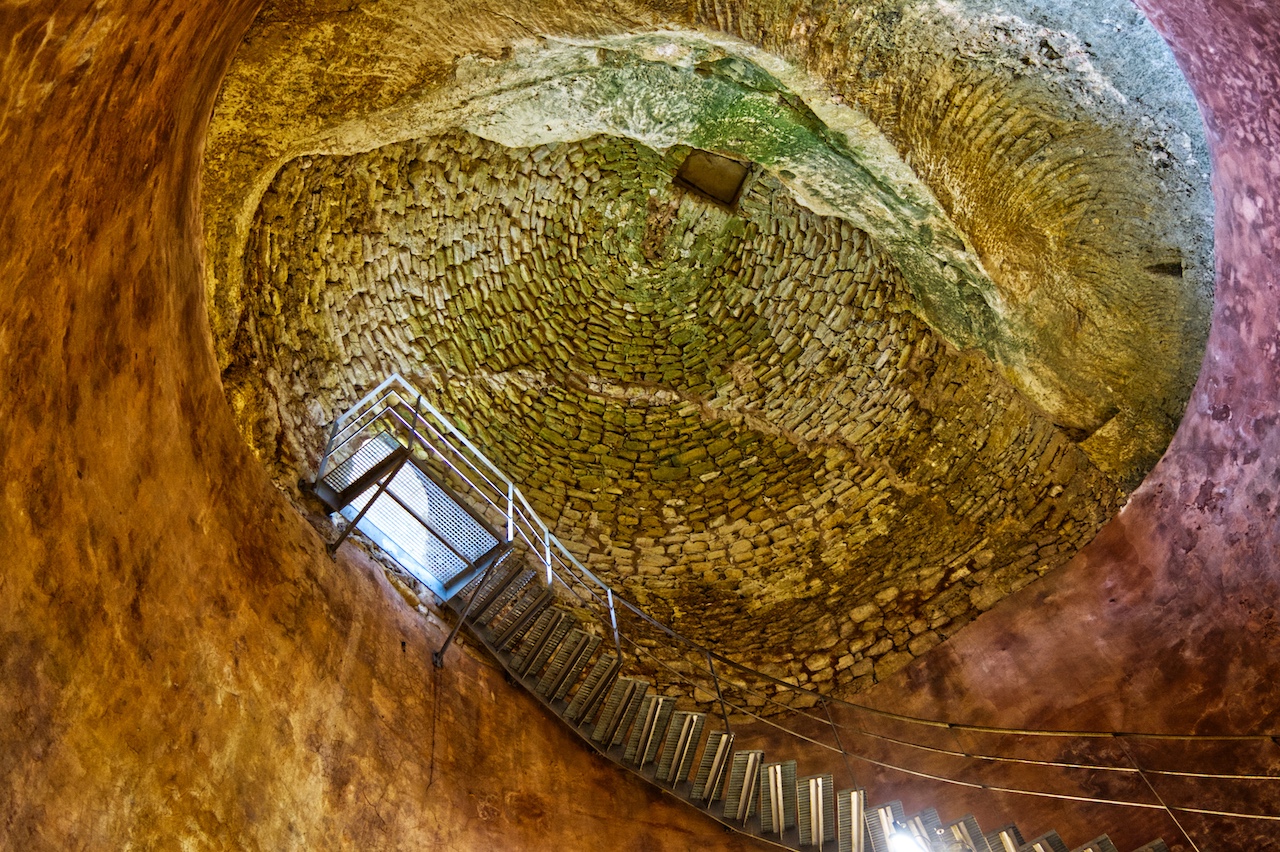
Bocairente is a charming town in the Valencian mountains, steeped in history and culture. Renowned for its cave houses and Moorish architecture, Bocairente offers visitors a unique glimpse into the region’s rich past.
Highlights:
- Cave houses: Bocairente is home to over 800 cave houses, dating back over a thousand years. These unique dwellings offer a fascinating glimpse into the lives of the town’s early inhabitants.
- Moorish architecture: Bocairente’s Moorish heritage is evident in its many well-preserved monuments, including the Covetes dels Moros (Moorish Caves), the Castillo de Bocairente (Bocairente Castle), and the Iglesia de Nuestra Señora de la Asunción (Church of Our Lady of the Assumption).
- Museums and art galleries: Bocairente is home to several museums and art galleries, including the Museu Arqueològic de Bocairent (Bocairente Archaeological Museum), the Museu Etnològic de Bocairent (Bocairente Ethnological Museum), and the Museu de l’Alfareria de Bocairent (Bocairente Pottery Museum).
Distance: 60 miles (97 kilometers)
How to get there:
- By car: Renting a car provides flexibility and convenience, allowing you to explore the surrounding areas at your own pace. Drive from Valencia to Bocairente via the V-21 motorway north towards Sagunto, exiting at junction 4. Follow the signs for Bocairente. The drive takes about 1 hour and 15 minutes.
- Take a tour: There are a few tour options you can do for a full day from Valencia. It’s a very scenic drive. This is by far the easiest and most informative way to enjoy this
- By bus: Take a regular bus service from Valencia to Bocairente. The bus ride takes about 1 hour and 30 minutes. The bus stop is located at the corner of Calle Colón and Calle Xàtiva.
- By train: Take a train service from Valencia to Bocairente. The train ride takes about 1 hour and 45 minutes. The train station is located at Calle Játiva 29. You can buy tickets through Trainline or Omio.
13. Montanejos Hot Springs (1 hour 15 minutes)
Montanejos is not merely a destination; it’s an experience that [seriously!] rejuvenates the body and soul. The minerals infused in these warm waters, including magnesium, calcium, and iron, are believed to promote overall well-being, making it a haven for those seeking natural healing. While the temperature may not match that of a hot tub, the gentle warmth of the springs offers a therapeutic embrace, soothing tired muscles and revitalizing the senses.
Deep in the rugged terrain of mountains and gorges lies Montanejos, a hidden sanctuary renowned for its hot springs and scenic beauty. The region’s natural wonders are epitomized by the Fuente de los Baños, where crystalline waters bubble up from the earth at a constant temperature of 77°F (25°C) throughout the year. This is not just a geographical marvel; it’s a testament to centuries of history and healing traditions which the the Romans also recognized.
Immerse yourself in the soothing embrace of the Salto de la Novia, also known as Bridal Veil Waterfall in Navajas, where legends of love and adventure echo through the surrounding cliffs. Despite the melancholic tale that lends the waterfall its name, it has become a cherished local swimming spot, inviting travelers to slide over rocks and capture moments beneath its cascading waters.
Distance from Valencia: Approximately 56 miles (90 kilometers)
Best Ways to Get to Montanejos from Valencia:
-
- By Car: Renting a car provides flexibility and convenience, allowing you to explore the surrounding areas at your own pace.
- By Car: Renting a car provides flexibility and convenience, allowing you to explore the surrounding areas at your own pace.
- By Bus: Several bus services operate between Valencia and Montanejos, providing a budget-friendly option for travelers.
- By Train: Opt for a train journey to nearby stations, followed by a short bus or taxi ride to reach Montanejos and its rejuvenating hot springs. You can buy tickets through Trainline or Omio.
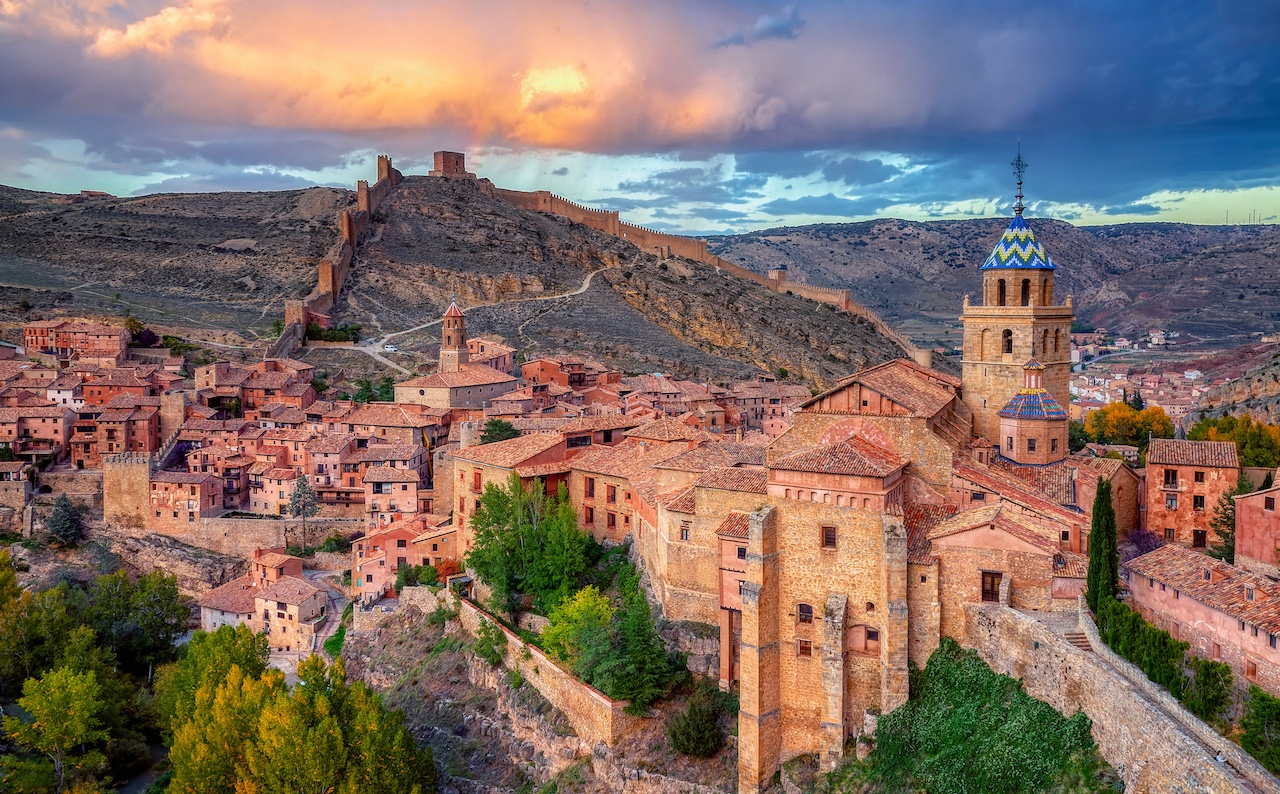
14. Teruel (1.5 hours)
Teruel is a captivating city and perfect for travelers looking for a day of exploration and cultural richness. Situated just a few hours away from Valencia, Teruel stands as a testament to Spain’s rich heritage and offers a perfect day-trip experience for those craving a taste of the past. Renowned for its Mudéjar architecture, a UNESCO World Heritage Site, Teruel boasts a remarkable collection of well-preserved buildings, including the stunning Teruel Cathedral and the iconic Torre del Salvador.
Beyond its architectural marvels, Teruel enchants visitors with its warm hospitality, delectable cuisine, and vibrant atmosphere that makes it an exceptional destination for a (long) day visit from Valencia. You may want to consider an overnighter to enjoy this excursion. The Teruel Tourism Bureau has a fantastic PDF map you can look at before the trip.
Per the city’s website ~ Teruel is the world capital of Mudejar architecture and birthplace of dinosaurs!
Distance from Valencia: The distance from Valencia to Teruel is approximately 141 miles (227 kilometers)
Best way to get from Valencia to Teruel: Seasonally, there are also full-day tours from Valencia.
- By Car: Renting a car provides flexibility and convenience, allowing you to explore Teruel and its surrounding areas at your own pace. The journey takes approximately 2.5 to 3 hours via the A-23 highway.
- By Train: Renfe, the Spanish national railway company, operates direct trains from Valencia to Teruel. You can buy tickets through Trainline or Omio. The journey takes around 2.5 to 3 hours, and trains offer a comfortable and scenic way to travel between the cities. Make sure to check the train schedules and book tickets in advance to secure the best prices.
- By Bus: While it takes longer than the train or car, buses can be a viable option if you’re looking to save money. Several bus companies operate services between Valencia and Teruel. Buses are a budget-friendly option, and the journey takes around 4 to 5 hours, depending on the route and stops.
- By BlaBlaCar or Carpooling: BlaBlaCar is a carpooling service where you can share a ride with someone driving from Valencia to Teruel. It can be a cost-effective and sociable way to travel, especially if you’re open to meeting new people.
15. Alicante (2 hours)
Alicante is a bit further away but easily accessible by train and car. Nestled along the Costa Blanca, this sun-kissed gem is a captivating coastal destination that seamlessly melds history, culture, and beachfront beauty.

The city’s historic heart is dominated by the imposing Santa Bárbara Castle, perched atop a rocky outcrop, offering panoramic views of the Mediterranean Sea. Alicante’s beaches, including the popular Playa del Postiguet, invite sun-seekers and water enthusiasts for leisurely days basking in the sun or engaging in thrilling water sports. The city’s charming Old Town, with its narrow cobblestone streets and colorful houses, is a treasure trove of tapas bars, local markets, and vibrant nightlife.
Alicante also offers a rich cultural scene, evident in its numerous museums and art galleries, celebrating the region’s heritage. We loved strolling along the Explanada de España, with its palm-lined promenade, often with street performers, bustling cafes, and a gorgeous view of the marina. For nature lovers, the nearby Mount Benacantil Nature Reserve offers hiking trails and diverse flora and fauna.
Distance from Valencia: Approximately 109 miles (176 kilometers)
Best ways to get from Valencia to Alicante: (we took the train, it’s easy and fun)
- By Train: Renfe, the Spanish national railway company, operates regular train services between Valencia and Alicante. Buy tickets through Trainline or Omio. The central train station in Valencia is known as Estació Nord. You’ll find it at the core of Valencia’s historic district, it serves as the primary gateway for trains traveling to and from the city.
- By Car: Renting a car provides flexibility and convenience, allowing travelers to explore the region at their own pace. The journey from Valencia to Alicante via the AP-7 highway is straightforward and offers a comfortable drive.
- By Tour: This is one of the best ways to visit Alicante, you’ll get a full-day tour and none of the worry about driving while you learn more about this amazing destination.
- By Bus: Several bus companies, such as ALSA, provide reliable and affordable bus services connecting Valencia and Alicante. Buses offer a budget-friendly option and a chance to enjoy the picturesque countryside during the journey
- Shared Ride (like BlaBla Car) or Taxi: Sharing a ride or taking a taxi is a convenient door-to-door option, particularly if you’re traveling with luggage or in a group. This choice offers personalized transportation and saves time.

Where To Stay In Valencia
The old town “Ciutat Vella” of Valencia is small and very walkable. Parking can be a bit of a challenge as it is across Europe’s popular, older cities. And often hotels charge quite a bit. A suggestion would be to stay as close to the old town as possible, then everything is within walking distance. Rent a car as needed. My favorite hotel Palacio Vallier is also actually a fabulous place to enjoy Agua de Valencia (drink), and explore the incredible interiors including custom Lladros.
How I rate hotels: For hotel criteria, I insist on clean and close. I also always look at value and go through reviews when I haven’t stayed at the hotel myself. My suggestions for budget accommodations are either 2-3-stars or under $100, and sometimes include hostels. For mid-range in Europe, it’s 4-star and high-end, it’s 5-star or something so unique to set it apart such as location or proximity to a particular attraction, and both mid-range and luxury must have a restaurant and a bar, but most of that is pretty common for European hotels.
📍Budget Option: Hotel RH Sorolla Centro. This hotel is a 9.7 as far as great location, and under $100 in the offseason. Super clean and convenient. They also offer bike and car rentals.
📍Mid-Range Option: The Valentia Corretgería. Exclusive boutique hotel in the heart of Valencia, a historic and emblematic building completely renovated with elegant and exclusive interior design. Located next to the Valencia Cathedral and its Miguelete, the hotel is in the most contemporary and lively part of the city. This gorgeous 4-star hotel also offers an airport shuttle.
📍Luxury Option: MYR Palacio Vallier. This is by far one of the loveliest hotels we’ve ever stayed at with the absolute best location! A 19th-century mansion located in the most beautiful part of Valencia’s old town, with a unique atmosphere thanks to the remains of a Roman perfumery dating back to the third century discovered during refurbishment. Go here for a cocktail even if you don’t stay, and admire the artwork.

Valencia FAQs
Even though Valencia is the 3rd largest city, it is often overlooked, which actually makes it an ideal spot to use as a hub. It’s more reasonable than the big cities and it’s home to paella along with many other unique attractions. The only downside to Valencia is the heat, so try if you can to avoid the midsummer. Here are some of the most frequently asked questions about Valencia, to help you plan your trip:
How many days do you need for Valencia?
If you just plan on seeing Valencia and not doing any of the day trips, then three days are enough. If you do take advantage of using Valencia as a hub, you can easily spend one to two weeks in Valencia with day trips. And, both Mallorca and Ibiza are a short flight from Valencia, so not technically a day trip but an excellent add-on. Read more about our Mallorca trip here.
Where can you travel from Valencia?
You can easily travel anywhere in Europe from Valencia. They have excellent railway and bus systems and a fabulous international airport. When we go to Spain, we usually rely on the train — It’s quite straightforward. Valencia has a comprehensive local public transport network operated by Empresa Municipal de Transportes de València (EMT Valencia) for city transit.
For intercity travel, there are long-distance bus services operated by major companies such as Alsa and Avanza, which have extensive networks covering all of Peninsular Spain and even some international routes. The city also has taxi services that are easily available for more direct and private transportation. Moreover, Spain’s high-speed trains, operated by Renfe, can connect Valencia to other major cities in Spain and beyond efficiently. The cost of public transport is quite affordable, with local bus fares generally under $2.00 USD, making it economical to travel to other areas from Valencia.
Flying from Valencia to other locations is also very easy. Valencia Airport (Manises) is approximately 5 miles west of the city center and provides frequent bus services, metro lines, and taxis for easy access to the city. The airport connects to many domestic and international destinations, allowing for simple onward travel from Valencia. With its close proximity to the city and a variety of flight options, Valencia Airport is a convenient starting point for reaching other places and an ideal hub for your Day Trips.
➡️ Learn more about where Valencia is by visiting this comprehensive guide.
What is the best month to visit Valencia?
The best month to visit Valencia is October, followed by May. Both spring and fall shoulder seasons have fewer tourists overall, and the temperatures are more manageable. Note that in winter, many places close up until the ‘season’ begins again, so be sure to check out your activities before you go. Learn more about Valencia’s holidays and seasons here. Summer can be extremely hot and is often more crowded.
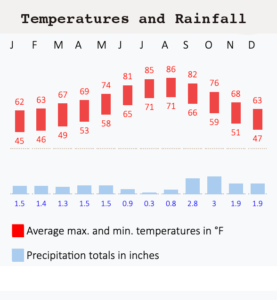
Is Valencia worth a trip?
ABSOLUTELY Valencia is worth a trip! Valencia is one of Spain’s most wonderful cities and the number of fabulous day trips from Valencia make it an ideal location to explore more of this stunning coastal region.
My Final Thoughts
Embarking on Valencia’s best day trips is an enriching journey that unveils the hidden treasures of Spain’s eastern coast. As an avid traveler and travel agent, my month-long stay in Spain was not only a visit but a deep exploration of Valencia and its surroundings.
From the serene El Saler Beach to the historic Sagunto and the picturesque vineyards of Utiel-Requena, each destination offers a distinct experience, making Valencia an ideal hub for diverse adventures. These trips vary from relaxing half-day excursions to immersive full-day explorations, catering to different interests, whether it’s soaking in the coastal beauty, delving into cultural heritage, or savoring local culinary delights.
Despite being overshadowed by Madrid and Barcelona, Valencia shines with its own unique charm, featuring walkable streets, prominent landmarks, and authentic Spanish flavors, especially its renowned paella. Utilizing Valencia as a base, one can effortlessly discover the captivating landscapes and rich cultural mosaic of Spain’s eastern regions.
This guide offers more than just a list of places; it’s a portal to experiencing the vibrant and varied facets of Spanish life through the lens of Valencia, a city that continually invites exploration and return visits. I can hardly wait to go back!!
Some travel resources while planning your day trips
- For regular day tours and activities, I recommend Viator and Get Your Guide. As a travel agent, I also have connections to more unique tours and activities, so drop me an email and we can discuss your specific needs, including special events and group tour information.
- For hotels, I do my preliminary research on Google and recommend Booking.com for DIY’s and as a travel agent, I have access to thousands of inventory options in every country often with additional perks provided to professionals. I’m also a Virtuoso agent, so if you’re looking for ultra-luxe travel, please reach out to me directly.
- For train transportation, you can buy tickets through Trainline or Omio.
- And for basic clothes, and gadgets like cables and converters, Amazon is my go-to. They’re also pretty good with clothing options.
- Rental Cars – I use RentalCars, but always check the ratings for each company.
- Insurance – I love Squaremouth because it gives buyers so many options and their helpline is great. Within SM, I try to use Allianz.
Another sidenote about Valencia…
According to Forbes 2023 list, Valencia is ranked #3 in best places for ExPats to live.
You might also enjoy this Port de Soller in Mallorca blog post:
And:



